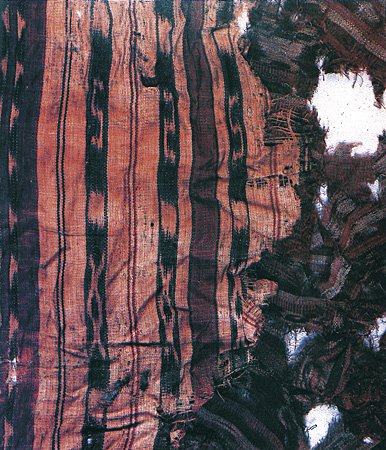Cultural Center of the Philippines
ENCYCLOPEDIA OF
PHILIPPINE ART
[Banton Burial Cloth]
Ca 14th-15th century / Abaca, warp ikat / 81 x 21 cm / Artist: Anonymous / National Museum of the Philippines collection
The Banton burial cloth is the oldest surviving specimen of textile in the Philippines. The description given to this abaca piece derives from its discovery in a cave in Banton Island, Romblon. Found accidentally in 1939 by Restituto Fonte, a farm boy who saw the cloth relatively intact inside one of several wooden coffins found together with human skulls and bones, and blue and white ceramics. The bones are believed to be from secondary burials. It is in its association with human remains that the cloth is thus described as a burial cloth. The artifact was eventually brought to the National Museum through the efforts of Gabriel F. Fabella, who was then a professor at the Department of History, University of the Philippines, who was also from Romblon.
The Banton cloth is also the earliest known warp ikat textile in Southeast Asia. Ikat is a resist technique that involves the dyeing of the textile fibers prior to weaving. In warp ikat, only the warp fibers are dyed. In the artifact, the dyes used are evident in the red and black fibers, while the whitish color comes from the undyed natural color of the fibers. The design on the Banton cloth is simple, composed of stripes of varying widths, interrupted at certain points by a core of patterns, such as regular and inverted “S” shapes, stylized “Xs” or tendril-like patterns with hooklike extensions, and positive and negative triangular shapes poised opposite each other to suggest either diamond- or hourglass-like patterns. Interestingly enough, both the palette and the patterns resonate in warp ikat textiles in southern Philippines, such as those of the Tboli, Subanon, and Mandaya. However, the patterns on the Banton cloth may be recognized as much simpler, possibly indicating the incipient stages of a design that would later blossom, as it were, in more recent versions of ikat textiles from areas other than Romblon. Also, in the Banton burial cloth, the stripes retain their integrity, while in the specimens from other ethnolinguistic groups, the stripes seem to be covered by a veil of intricate motifs.
Currently, Romblon does not have a surviving tradition of cloth production using the ikat technique. It is quite possible that the Banton burial cloth is evidence of an ancient tradition of weaving now lost. Moreover, the circumstances in which the Banton cloth was found strongly suggest the importance of cloth in ritual contexts. Its association with blue and white pottery might also intimate the cloth’s function as prestige object.
Written by Marilyn R. Canta
Sources
Faminiano, Abner F. 2014. “Do You Know That …” Bantoanon Historical & Cultural Tidbits 3.1 Accessed 15 Jun.
Medrano, Jack Gilbert Lauyan. 2005. “The People of Ancient Banton: Assemblage Composition, Population Features, and Health through Osteological Analysis.” MS thesis, University of the Philippines Diliman.
National Museum of the Philippines. 2014a. “Banton Cloth.” Collections. 10 Feb. Accessed 9 Jun 2014. http://www.nationalmuseum.gov.ph/nationalmuseumbeta/Collections/Archaeo/Banton.html.
